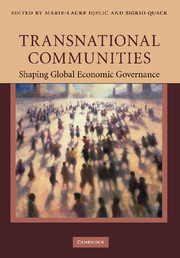Book contents
- Frontmatter
- Contents
- List of figures
- List of tables
- List of appendices
- Contributors
- Preface
- Part I Introduction
- 1 Transnational communities and governance
- 2 Global structures: markets, organizations, networks – and communities?
- Part II Classical communities with a transnational extension
- Part III Professional communities with a transnational extension
- Part IV Virtual communities
- Part V Transnational interest- or issue-based communities
- Part VI Conclusion
- Index
- References
1 - Transnational communities and governance
Published online by Cambridge University Press: 07 September 2010
- Frontmatter
- Contents
- List of figures
- List of tables
- List of appendices
- Contributors
- Preface
- Part I Introduction
- 1 Transnational communities and governance
- 2 Global structures: markets, organizations, networks – and communities?
- Part II Classical communities with a transnational extension
- Part III Professional communities with a transnational extension
- Part IV Virtual communities
- Part V Transnational interest- or issue-based communities
- Part VI Conclusion
- Index
- References
Summary
The dichotomy of Gemeinschaft and Gesellschaft, as coined originally by Ferdinand Tönnies, has profoundly shaped the use of the concept of “community” in the social sciences (Tönnies 2002 [1897]). As shown by Renate Mayntz in this volume, the term “community,” when used alone and not qualified, still tends to suggest close-knit if not primary groups with rich emotional ties. It also conjures up geography and bounded space, local connectedness and physical proximity.
As such, the concept of community often stands in an awkward position in the study of contemporary, differentiated, and individualist societies. It has been mobilized descriptively to suggest the resilience of certain traditional ties, even in the context of rapid individualization and differentiation (Park and Burgess 1921; Park 1952). It has also been used normatively to argue for the need to preserve such forms of close-knit social organization in the face of progressive social anomie and disintegration (Bellah et al. 1985; Putnam 2000). On the whole, however, the decline of community (Gemeinschaft) has tended to be contrasted with the progress of Gesellschaft – understood as an association of individual and differentiated members coming together more or less permanently, mostly to serve their own interests. In contemporary literature, an urge to reconcile the term “community” with the evolution of our world – including the progress of Gesellschaft as a dominant form of social organization more or less everywhere – is palpable.
- Type
- Chapter
- Information
- Transnational CommunitiesShaping Global Economic Governance, pp. 3 - 36Publisher: Cambridge University PressPrint publication year: 2010
References
- 22
- Cited by



